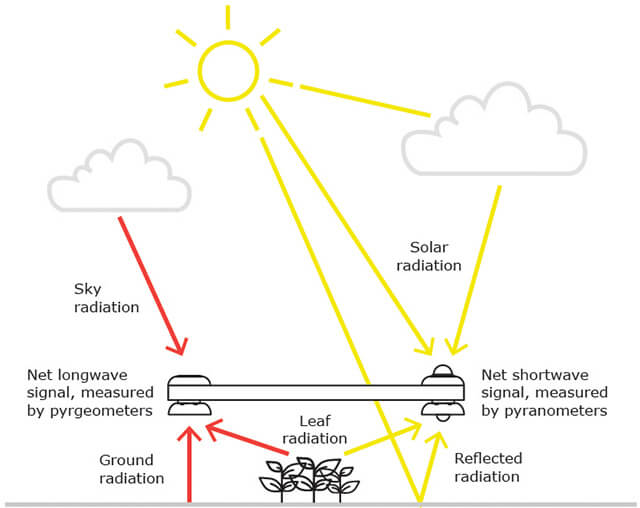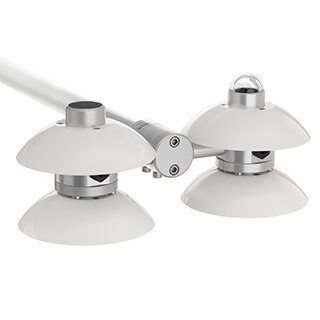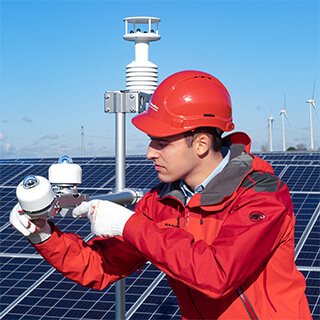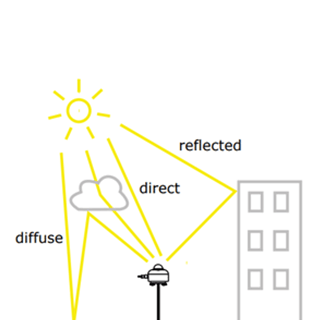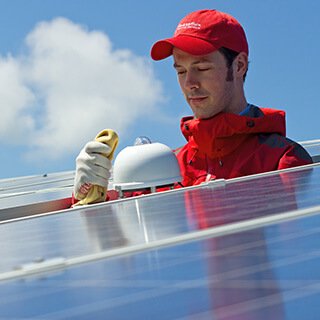Measuring sunlight: what instrument to use?
To measure solar radiation or sunlight a pyranometer, albedometer and pyrheliometer can be used. Each sensor measures a different part of the spectrum and has different directional properties (field of view). For measuring sunlight intensity, it is important to know what part of the spectrum you want to measure and in which direction. You can then choose what instruments you need to measure, for example, the sunlight intensity within a 180- or a 5-degree field of view angle. This article explains what the sun emits, how to measure sunlight intensity, which instruments are used and why we measure sunlight.
Categories of sunlight
If you want to know how to measure sunlight intensity, you need to understand the spectrum that the sun emits. Sunlight, also known as sunshine, can be categorised into three main types:
- Visible light: wavelengths between 0.4 – 0.7 micrometers
- Ultraviolet light: wavelengths between 0.1 - 0.4 micrometers
- Infrared radiation: wavelengths between 0.7 micrometers - 1000 micrometer
For measuring sunlight intensity or atmospheric radiation we are interested in two categories:
- Solar radiation: wavelengths between 0.4 - 3 micrometers
- Far infra-red: wavelengths between 3 - 1000 micrometers

area that the sun emits. Ranging from 0.4 and 3 micrometers.
The sun radiates a range of wavelengths that can be measured. In order to measure certain wavelengths in particular angles that are direct, scattered or diffused, a specific solar radiation sensor is needed.
Solar Irradiance
Solar irradiance is a form of electromagnetic radiation which we receive from the sun. When no clouds and direct solar radiation go through our atmosphere, it is experienced as sunshine giving radiant heat and a bright beam of light. The solar beam is called “direct solar radiation”. Solar irradiance does not necessarily need to be direct. It can also reach us via reflection or scattering. There are several types of solar irradiance that can be measured. For each of these solar irradiances, a certain solar radiation sensor can be used.
1. Direct Normal Irradiance (DNI) & pyrheliometer
Direct Normal Irradiance, also called beam radiation, can be measured with a pyrheliometer. A pyrheliometer is pointed directly at the sun as it tries to catch the direct beam radiation. To be pointed at the sun, it should be mounted on a solar tracker: a device that follows the sun’s movement throughout the day. Most pyrheliometers have a 5° field of view angle in order to only measure the direct beam and create an accurate measurement.
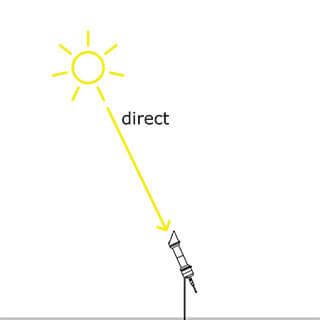
in order to measure the direct solar radiation.
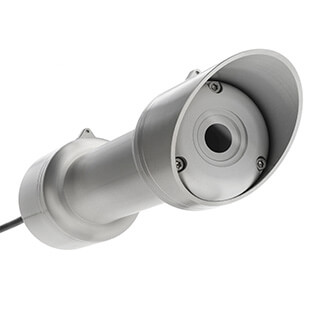
2. Diffuse Horizontal Irradiance (DHI) & pyranometers
Diffuse Horizontal Irradiance is the irradiance received from the sun that is scattered or diffused by the atmosphere. This can be measured with a pyranometer. Unlike the pyrheliometer that only tries to catch and measure the direct solar radiation, for DHI measurements all the horizontal irradiance that does not come from the direct beam of the sun is being measured. To only measure diffused or scattered beams of the sun, a ball or disc that tracks the sun can be placed above the pyranometer. This ball or disc only removes the 5° cone around the sun. In this way, it shades the direct beam, and only diffuse light is measured. The pyranometer has a hemispherical field of view angle (180°) and in this instance, the effective field of view angle is reduced to 175° due to the blocking ball.

the direct solar radiation in order to measure the DHI.

in order to only receive diffuse irradiance.
3. Global Horizontal Irradiance (GHI) & pyranometers
Global Horizontal Irradiance is the total irradiance measured from the sun on a horizontal surface on earth. This is the sum of the direct horizontal irradiance and diffuse horizontal irradiance. This can also be measured with a pyranometer but without the tracking ball. The choice between using a combination of a pyrheliometer and a shaded pyranometer or just a single pyranometer depends on the specific requirements of measuring GHI and cost. Both solutions are possible, but the pyrheliometer + shade pyranometer combination is more accurate than a single pyranometer. On the other hand, pyrheliometers are more expensive and also more difficult to operate. So, for measurements for GHI, the combination of DHI and DNI with a direct sun tracking pyrheliometer and direct sun blocking pyranometer will result in relatively more accurate results than just a pyranometer but is also more expensive.
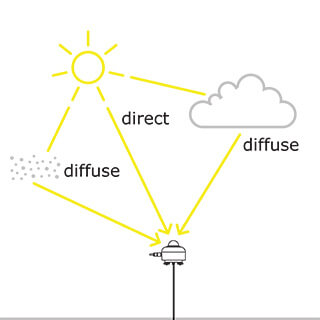
DHI and DNI to measure GHI.

4. Plane of Array (POA) Irradiance
The Plane of Array (POA) is the total radiation received on a tilted surface. It is possible to tilt our pyranometers to measure POA. This is relevant for photovoltaic power (PV) plants that are mounted at a defined tilt. PV mounting frames can be fixed or sun tracking. If the measuring device is tilted, the POA can be broken down into Diffuse Tilted Irradiance (DTI) and (Direct) Beam Tilted Irradiance (BTI). DTI and BTI are the same as DHI and DNI but only differ because the measuring device is tilted.
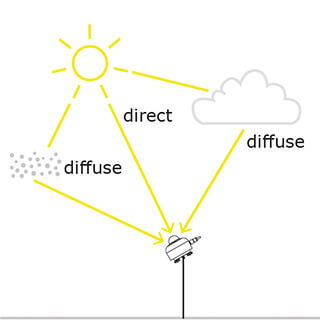
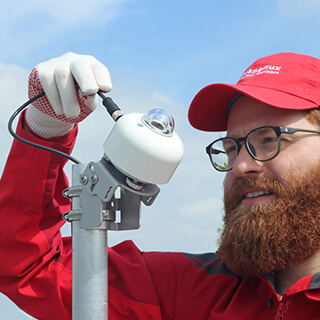
PMF01 mounting fixture.
5. Reflected solar radiation & albedometers
Reflected solar radiation can be measured with an albedometer. Basically, an albedometer is a combination of two pyranometers: one facing up and one facing down, both with a field of view angle of 180°. With an albedometer, measurements of global solar radiation (GHI) and reflected radiation are possible. The ratio of reflected radiation to global radiation is called albedo. Sometimes it is important to use an albedometer instead of just a pyranometer in environments with high albedo. Places with snow and ice cause for more reflection from the ground resulting in higher albedo. For climatologists, it is important to monitor albedo change as positive feedback loops can occur in certain environments.
Read more about albedo measurements in our article: What is albedo?
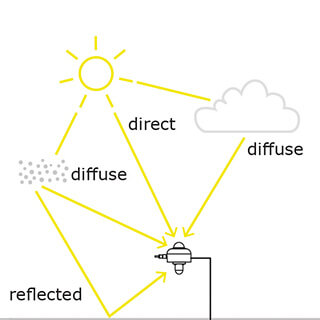
of two pyranometers. With both measurements
of GHI and reflected solar radiation.

Practical applications for measuring solar radiation
There are multiple practical applications for solar radiation sensors. Below you will find a list of the most common practices that involve solar radiation sensors:
- Weather forecasting and climate studies: Gathering data on solar radiation and reflected solar radiation is crucial for accurate weather predictions and long-term climate studies. Albedo, for instance, can provide insights into climate change in different environmental conditions.
- Solar energy installations: Having knowledge and data on Plane of Array (POA) and Direct Normal Irradiance (DNI) is essential for analysing and optimising the performance and positioning of solar panels in photovoltaic power plants.
- Agricultural planning: Understanding the amount of sunlight, including direct and diffuse horizontal irradiance, that a specific area receives can help in planning agricultural activities and increase crop yields.
- Environmental monitoring: With instruments like net radiometers, an energy budget assessment can be made, enabling researchers to study if solar energy is being stored in the ground, lost or reflected back to space.
Don’t know what solar radiation sensor to use? Here are a few selection criteria:
- Purpose: Define what you need to measure. For reflected and global radiation an albedometer would be appropriate. If you only need to measure the direct beam radiation, a pyrheliometer would be necessary.
- Accuracy: It’s important to know the level of precision that is needed for your activity in measuring solar radiation. Pyrheliometers will give a more accurate result from the direct beam radiation than from a pyranometer, but they are also more expensive and difficult to operate.
- Budget: Balance the need for accuracy with budget constraints. Most of the time instruments that yield more accurate results come with higher prices.
- Environmental conditions: Be aware of what environmental area you will place your measuring device. A place with snow or ice will come with higher albedo and become more important to measure.
- Ease of operation: Before purchasing, assess the level of operation the measuring device needs from you. More sophisticated instruments are more complicated to use and require a deeper understanding.
- Maintenance and calibration: Some instruments need daily or weekly maintenance compared to other devices. Evaluate if you are able to maintain and calibrate the devices to the standards that are required.
At Hukseflux, you can order each of the specific solar radiation sensors mentioned above. Hukseflux enables you to make a comprehensive assessment of solar radiation, resulting in an accurately calculated energy budget, or provides you with accurate data that suits your needs.
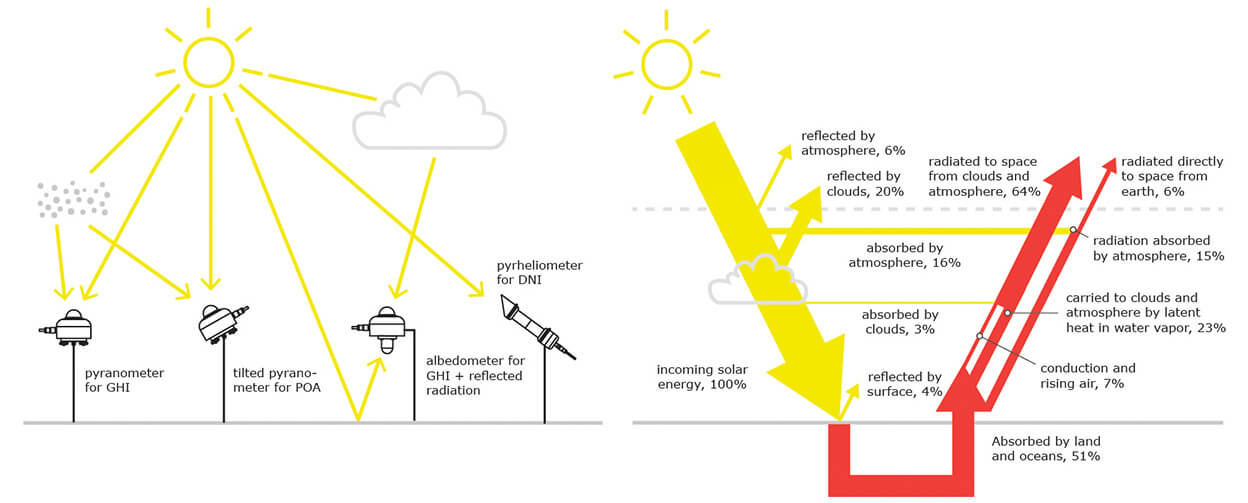
Atmospheric Radiation
Longwave and shortwave irradiance: pyrgeometers & net radiometers
Pyrgeometers are used to measure longwave infrared radiation and pyranometers are used for short-wave radiation. Longwave irradiance is the part of the infra-red radiation that is not emitted by the sun. Accurate longwave irradiance measurements are important for understanding long term earth-atmosphere-ocean climate changes.
It is possible to combine pyrgeometers with pyranometers. Using up-and-downfacing pyranometers and pyrgeometers, you may construct a so-called net-radiometer. With a net radiometer, four measurements can be made. From these 4 measurements, a net energy budget can be calculated. This assessment helps us better understand how solar and infra-red energy is stored, reflected or emitted back to space.
